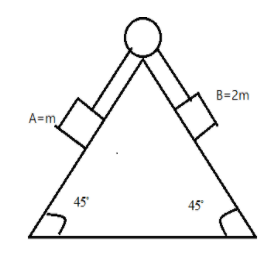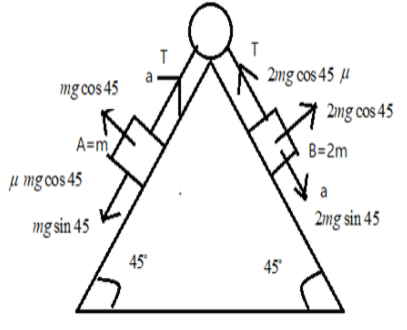
Consider the diagram shown in which two masses of $m$ and $2\;m$ are placed on a fixed triangular wedge. The coefficient of friction between block A and the wedge is $\dfrac{2}{3}$ while that for B and the wedge is $\dfrac{1}{3}$. If the whole system is released from rest, then the acceleration of block A is?

\[\begin{align}
& A.0 \\
& B.\dfrac{2{{m}^{2}}g}{3} \\
& C.\dfrac{4{{m}^{2}}g}{3} \\
& D.\dfrac{{{m}^{2}}g}{\sqrt{2}} \\
\end{align}\]

Answer
555k+ views
Hint: We form Newton's third law of motion, that every action has an equal and opposite reaction. Similarly, here the friction between the surface and the block is the opposing force, which resists the block from sliding through the surface.
Complete answer:
We know that there are two types of forces, namely the normal force which plays an important role in the friction, it is used in defining the Coefficient of static friction .Also, the Coefficient of static friction is a dimensionless quantity, and is denoted as $\mu_{s}$, it is the maximum resistive force applied on any given body such that there is no change in state of the motion. It is mathematically given as $\mu_{s}=\dfrac{F_{s}}{F_{n}}$, where $F_{s}$ is the applied force and $F_{n}$ is the normal force acting on the given body.
Here, we have a pulley mass system which is in motion, thus the blocks experience friction, with respect to the surface.
Given that at A $m$ is the mass and $\mu_{A}=\dfrac{2}{3}$ at B $2\;m$ is the mass and $\mu_{B}=\dfrac{1}{3}$.
From the figure, clearly the normal of the blocks A and B are $N_{A}=mgcos(45^{\circ})$ and $N_{B}=2mgcos(45^{\circ})$
Consider the free body diagram of the figure as shown below,

Let us consider that, the block A experiences acceleration $a$ in the upward direction, then the friction,$\dfrac{2mgcos(45^{\circ})}{3}$ acts in the downward direction. Similarly in the block B when released experiences an acceleration $a$ acts in the downward direction, then the friction $\dfrac{2mgcos(45^{\circ})}{3}$ acts in the upward direction as shown in the figure above.
Consider the free body diagram on B, we have,
$2mg sin(45^{\circ})+2ma=T+\mu_{B}N_{B}$
$\implies 2mgsin(45^{\circ})+2ma=T+\dfrac{2mgcos(45^{\circ})}{3}$
Similarly, the tension on the string due to A can be written as
$T+ma=mgsin(45^{\circ})+\mu_{A}N_{A}$
$\implies T=mgsin(45^{\circ})+\dfrac{2mgcos(45^{\circ})}{3}-ma$
Substituting for $T$, we get
$\implies 2mgsin(45^{\circ})+2ma=mgsin(45^{\circ})-ma+\dfrac{2mgcos(45^{\circ})}{3}+\dfrac{2mgcos(45^{\circ})}{3}$
$\implies 3ma= mgsin(45^{\circ})+\dfrac{2mgcos(45^{\circ})}{3}+\dfrac{2mgcos(45^{\circ})}{3}-2mgsin(45^{\circ})$
$\implies 3ma=\dfrac{4mgcos(45^{\circ})}{3}-mgsin(45^{\circ})$
$\implies 9ma=mgcos(45^{\circ})-3mgsin(45^{\circ})$
$\implies 9a=\dfrac{g}{\sqrt2}-\dfrac{3g}{\sqrt2}$
$\therefore a=\dfrac{-2g}{9\sqrt2}$
Since the value of acceleration cannot be negative, we can say that the only possible value of $a$ is $a=0$.
Thus the correct answer is option $A. 0$
Note:
Clearly, friction is the resistive force which tries to oppose the motion of an object. It is a surface phenomenon and is observed only when the given object tries to move with respect to some surface which is in contact. Thus we can say that friction is a contact force.Clearly, for the blocks to accelerate, they must overcome the frictional maximum limit, which here is the $\dfrac{2mgsin(45^{\circ})}{3}$ which is acting on the B block.
Complete answer:
We know that there are two types of forces, namely the normal force which plays an important role in the friction, it is used in defining the Coefficient of static friction .Also, the Coefficient of static friction is a dimensionless quantity, and is denoted as $\mu_{s}$, it is the maximum resistive force applied on any given body such that there is no change in state of the motion. It is mathematically given as $\mu_{s}=\dfrac{F_{s}}{F_{n}}$, where $F_{s}$ is the applied force and $F_{n}$ is the normal force acting on the given body.
Here, we have a pulley mass system which is in motion, thus the blocks experience friction, with respect to the surface.
Given that at A $m$ is the mass and $\mu_{A}=\dfrac{2}{3}$ at B $2\;m$ is the mass and $\mu_{B}=\dfrac{1}{3}$.
From the figure, clearly the normal of the blocks A and B are $N_{A}=mgcos(45^{\circ})$ and $N_{B}=2mgcos(45^{\circ})$
Consider the free body diagram of the figure as shown below,

Let us consider that, the block A experiences acceleration $a$ in the upward direction, then the friction,$\dfrac{2mgcos(45^{\circ})}{3}$ acts in the downward direction. Similarly in the block B when released experiences an acceleration $a$ acts in the downward direction, then the friction $\dfrac{2mgcos(45^{\circ})}{3}$ acts in the upward direction as shown in the figure above.
Consider the free body diagram on B, we have,
$2mg sin(45^{\circ})+2ma=T+\mu_{B}N_{B}$
$\implies 2mgsin(45^{\circ})+2ma=T+\dfrac{2mgcos(45^{\circ})}{3}$
Similarly, the tension on the string due to A can be written as
$T+ma=mgsin(45^{\circ})+\mu_{A}N_{A}$
$\implies T=mgsin(45^{\circ})+\dfrac{2mgcos(45^{\circ})}{3}-ma$
Substituting for $T$, we get
$\implies 2mgsin(45^{\circ})+2ma=mgsin(45^{\circ})-ma+\dfrac{2mgcos(45^{\circ})}{3}+\dfrac{2mgcos(45^{\circ})}{3}$
$\implies 3ma= mgsin(45^{\circ})+\dfrac{2mgcos(45^{\circ})}{3}+\dfrac{2mgcos(45^{\circ})}{3}-2mgsin(45^{\circ})$
$\implies 3ma=\dfrac{4mgcos(45^{\circ})}{3}-mgsin(45^{\circ})$
$\implies 9ma=mgcos(45^{\circ})-3mgsin(45^{\circ})$
$\implies 9a=\dfrac{g}{\sqrt2}-\dfrac{3g}{\sqrt2}$
$\therefore a=\dfrac{-2g}{9\sqrt2}$
Since the value of acceleration cannot be negative, we can say that the only possible value of $a$ is $a=0$.
Thus the correct answer is option $A. 0$
Note:
Clearly, friction is the resistive force which tries to oppose the motion of an object. It is a surface phenomenon and is observed only when the given object tries to move with respect to some surface which is in contact. Thus we can say that friction is a contact force.Clearly, for the blocks to accelerate, they must overcome the frictional maximum limit, which here is the $\dfrac{2mgsin(45^{\circ})}{3}$ which is acting on the B block.
Recently Updated Pages
Master Class 11 Social Science: Engaging Questions & Answers for Success

Master Class 11 Physics: Engaging Questions & Answers for Success

Master Class 11 Maths: Engaging Questions & Answers for Success

Master Class 11 Economics: Engaging Questions & Answers for Success

Master Class 11 Computer Science: Engaging Questions & Answers for Success

Master Class 11 Chemistry: Engaging Questions & Answers for Success

Trending doubts
What is meant by exothermic and endothermic reactions class 11 chemistry CBSE

10 examples of friction in our daily life

Difference Between Prokaryotic Cells and Eukaryotic Cells

1 Quintal is equal to a 110 kg b 10 kg c 100kg d 1000 class 11 physics CBSE

One Metric ton is equal to kg A 10000 B 1000 C 100 class 11 physics CBSE

Draw a diagram of a plant cell and label at least eight class 11 biology CBSE




